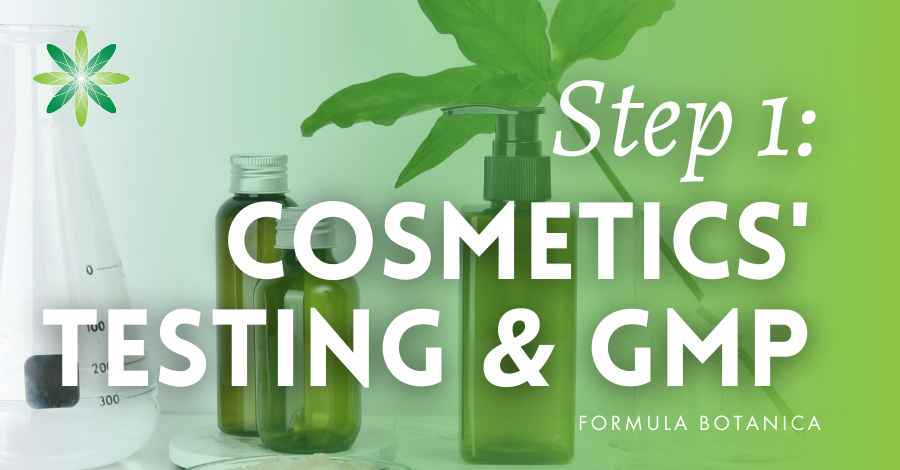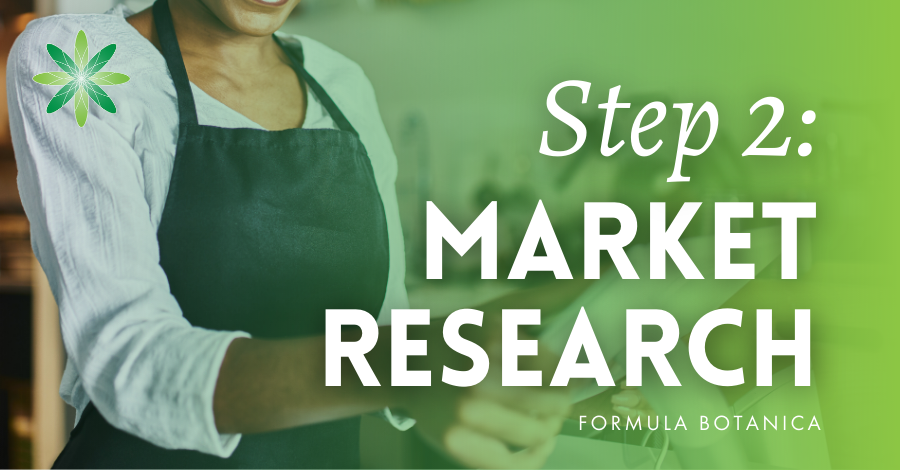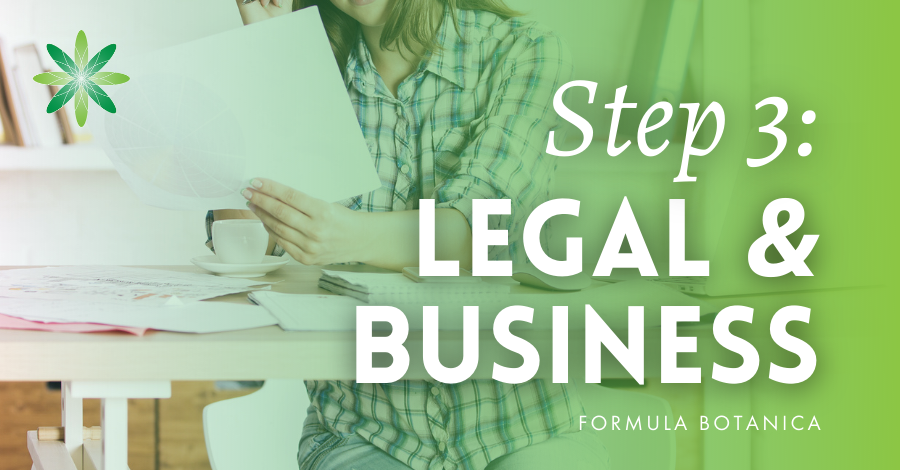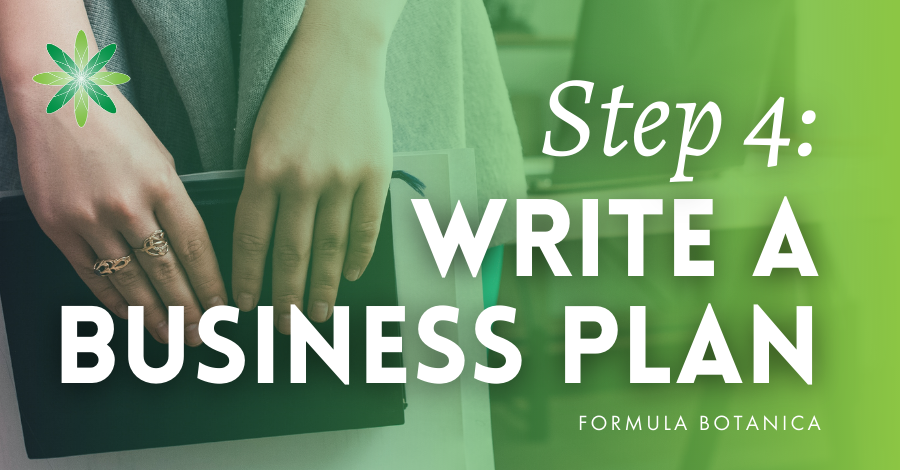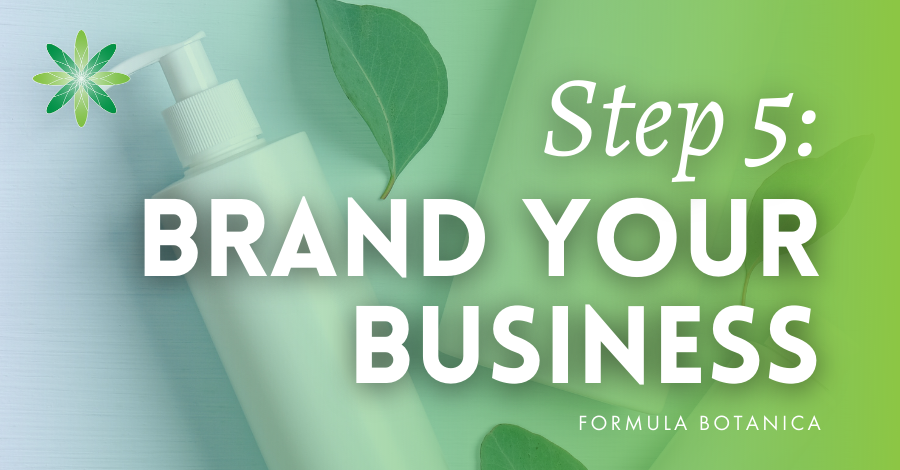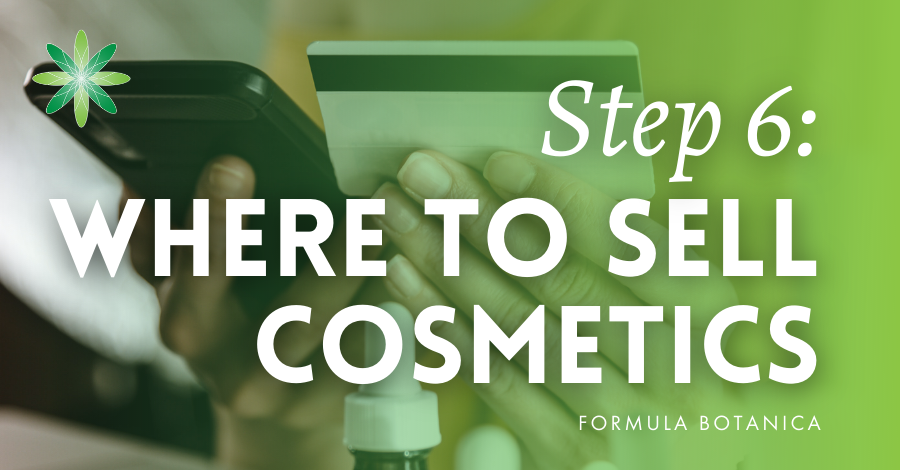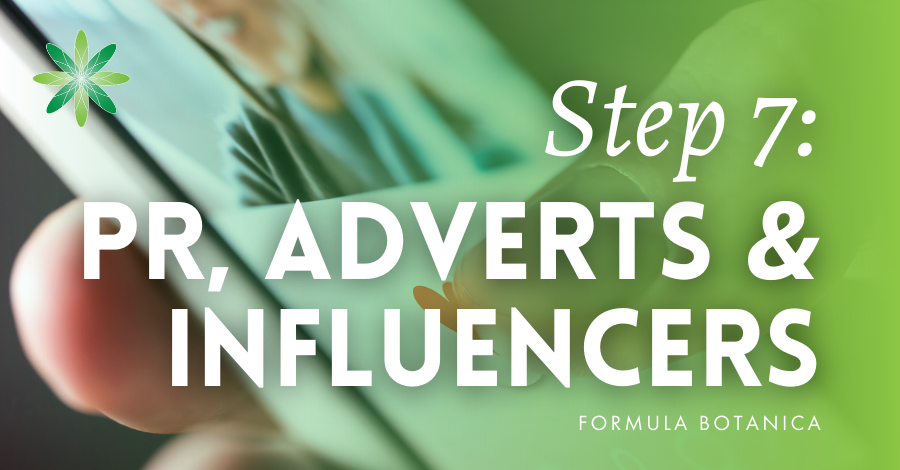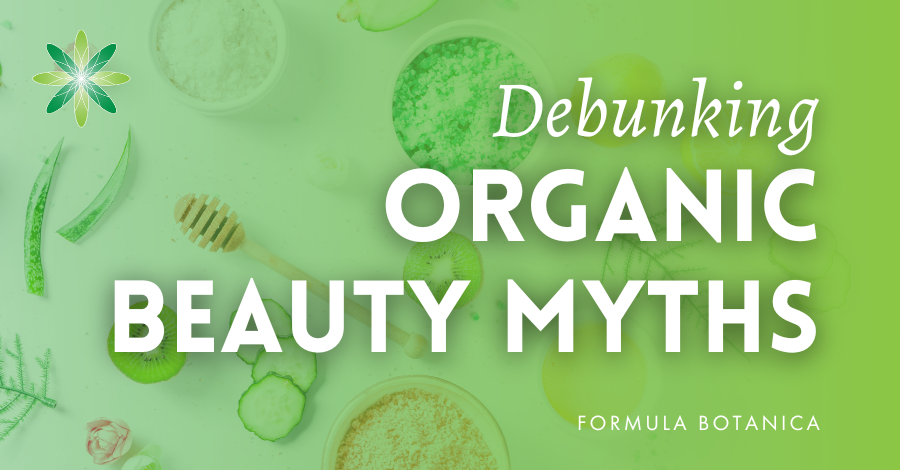With some 14,000-plus students and graduates and a 300K-strong community with us at Formula Botanica, we have seen hundreds of natural formulators take the leap from formulating for fun to wanting to sell homemade cosmetics. It’s a familiar story: you’ve made some lovely natural formulations and given your homemade skincare creations away to family and friends who come back with rave reviews and requests for refills.
This prompts you to start thinking about how to sell homemade cosmetics to not only recoup your costs but also turn a profit. The idea springs to mind that your hobby might become a profitable sideline to your day job and even grow into a successful indie beauty brand selling far and wide. We showcase on this site 200-plus Formula Botanica graduates who are already indie beauty entrepreneurs having discovered in natural formulation an empowering new career, and we’d love you to join them.
How to sell cosmetics: from formulation to first sale
Going from idea to reality does take some thought, action and budgeting. Selling homemade cosmetics is not a simple matter of setting up, for example, an Etsy shop or starting an Instagram account to showcase your products and expect sales to roll in.
In this blog post, we guide you through the stages, highlighting the areas on which you need complete clarity in order to succeed in selling your cosmetics professionally. We give you a broad understanding of what is required, but you will need to research further and inform yourself about your own country or region’s regulations on selling homemade cosmetics.
Use this index to jump to sections that interest you. If you are new to making and selling homemade cosmetics, we encourage you to read the entire article.
Table of Contents
- Step 1: Compliance: GMP, cosmetic regulations and testing
- Step 2: Market research: who are your customers?
- Step 3: Legal and admin: from start-up to scaling up
- Step 4: Business planning: financing your future
- Step 5: Branding: presenting your cosmetics
- Step 6: Sales channels: where to sell your cosmetics
- Step 7: Promotion: adverts and influencers
1. Compliance: GMP, cosmetic regulations and testing
Before you can sell, you must comply. The first, and most critical stage in selling your homemade cosmetics, is compliance with the law. In nearly every country, cosmetics must be formulated with strict adherence to health and safety regulations and pass certain tests to be placed on the market for sale.
Even big brands can have issues despite their products being formulated in professional, commercial labs and passing tests, as the Liz Earle brand discovered a few years ago. So, this is not an area to treat lightly.
License to sell homemade skincare
Before you spend any money on your home cosmetics business, first find out if in your country you are permitted to sell cosmetics made at home. Some countries do not permit the sale of homemade cosmetics, even if you have a separate room for your lab.
There are ways to still create your own brand and sell cosmetics but you may need to use a third-party to manufacture while you dedicate your energy to creating new formulations, running the business, marketing, selling and so on. Find out more in our article:
Safety, challenge and stability testing
Whether made in your home or by a white label manufacturer, your cosmetic products will need to undergo safety testing, microbial (challenge) tests if they contain water, and in most cases also stability testing. These tests are mandatory in virtually every country/jurisdiction and must be carried out by professional, third-party services, often referred to as safety assessors. They assess things like the suitability of any preservative systems in your formulations and determine the shelf life of your products, which is required information on your product container and packaging.
These links provide useful background reading on preservatives and testing:
5 Reasons why your natural formulations need preserving
3 Reasons all skincare products must undergo stability testing
You don’t always need to pay for a lab to carry out stability testing. Our Certificate in Cosmetic Stability Testing trains you on some 20 types of test you can carry out yourself.
Your home lab
We teach our Formula Botanica students to formulate from the start adhering to good manufacturing practice (GMP) in their home lab. In brief, this lays down a checklist of safety, hygiene and manufacturing process guidelines to follow. If you are setting your sights on selling your homemade cosmetics, we advise getting familiar with and working to GMP now.
To make cosmetics for sale, you will need to comply with relevant national/regional/local laws governing cosmetics’ manufacture and it is highly likely your premises will be inspected. You may need to demonstrate and provide evidence that you are manufacturing in accordance with GMP.
Keep updated, meticulous records of, as a minimum, your manufacturing processes, formulations, batches, supplies, pricing/costs, stock and more. In the EU, it is mandatory to compile a Product Information File (PIF) for each cosmetic product you manufacture and to retain this file for inspection. There are several software products available designed to help craft, artisan and small product businesses, and some are tailored to cosmetic manufacture. But you can use programs like Excel or similar to keep records. If a consumer has a problem with a product, you need to be able to trace the batch and the ingredient batches it contains. Attention to detail is everything.
Even if you are giving products away to friends and family, you should still be working to GMP and we advise you instill its practices into your home-lab formulating whether you sell products or not.
These articles have more information on home labs, GMP and the basics of formulating cosmetics at home:
Beginner’s guide to setting up a home formulation lab
8 points you must know before making homemade skincare
How to handle a FDA inspection
How to set up your artisan skincare lab
Lab equipment
You may need to upgrade or scale up your home lab equipment to more professional tools if you are making cosmetics for sale. Quite apart from needing to make larger batches, and therefore needing more robust, and higher capacity scales for example, you may need to buy equipment to enable you to comply with trading standards’ regulations.
For example, to use the ‘e’ estimate symbol on your packaging, you really need ‘trade-specific’ weighing scales. These are scales that are tested and verified to approved, highly accurate standards applicable for use in commercial settings. Again, check your local trading standards regulations to find out how to comply with weights and measures laws.
Cosmetic claims
Also worth mentioning in this section on compliance are any claims you might wish to use about your cosmetic products. In recent years, there has been a clamp down in most jurisdictions – in particular, the EU and USA – on the misuse of claims. Consumers are now highly aware also of greenwashing and are calling for greater transparency from beauty brands.
You should research and substantiate any claims you make about your cosmetic products whether about product ingredients’ or formulation efficacy or about the sustainability and green credentials of, for instance, your product, packaging, manufacturing or shipping. Recently, the UK announced even greater scrutiny of environmental claims and published a Green Claims Code to help businesses communicate their genuine green credentials and not mislead consumers.
While in the EU, use of the common wording ‘free from’ could spell trouble. If ingredients you list as being not present in a cosmetic product are in fact legally allowed in cosmetics at permitted percentages, the EU may see your ‘free from’ claims as unfair competitive practice.
As you can see, compliance extends to your marketing copy and branding, which we cover below, and is, rightly so, the first hurdle to selling your homemade cosmetics. No one wishes to sell cosmetics that could do harm to consumers or mislead them.
Changes to free-from claims
Podcast 3: How to comply with cosmetics’ regulations
EU cosmetics claims surveillance
2. Market Research: who are your customers?
You love your homemade cosmetics and so do your family and friends. But, do they represent your actual customers? Are they just being polite about your products or perhaps even too harsh in their criticism of them? Also, as natural formulators, we often create ranges to suit our own skincare needs. But, if you wish to sell your creations, you need to be clear about who your ideal customer is, and that may not be someone like you, your friends or family members.
In fact, we’ve often heard from our graduate brand owners how they started out with one type of customer in mind only to discover their actual customers later on were a totally different market.
Industry research
Market research is not only for large brands with significant marketing departments. Neither is it vague guesswork. There are plenty of things you can do to research and define your ideal customers and feed your insights into your formulations, branding and the tone of voice of your communications.
Sign up for beauty industry newsletters and start making note of the trends. You will start to get some clues about what is happening and how your products match the mood of the times. Sustainability is the buzzword in the beauty world. Consumers are voting with their pockets and increasingly making choices based on brands’ efforts to reduce, recycle and reuse, be climate neutral, water conscious and so on. Decide how your cosmetic formulations and brand story can play a part in this conversation.
Our podcasts have a wealth of information about latest issues in the industry from sustainability to skinimalism or minimalist skincare, and talk about the role indie beauty can play.
See also our post: Beauty trends on Pinterest
Competitor research
Indie beauty founders have one big advantage over the mainstream brands; the backstory of the founder – you. Your passion for your cosmetics, your formulations and the story of what drives you to create and sell them is huge part of your competitive edge. But, unique as you are, you will have competitors and you need to realise that offering natural, organic and green beauty products is not enough of a niche these days to stand out.
To get a feel for the naturals’ sector and how competitors position themselves, discover and follow at least 10 brands in a similar space. Learn from them – don’t copy them. See how they talk to their customers and other audiences and how they appeal and sell to customers. What are they doing that you can do better? How can you differentiate your products and voice from theirs?
Even if you are selling locally to start with, you may wish to expand sooner than you think. Future proof your identity by working our early on what your unique selling propositions are. Perhaps you have a specific local ingredient that sets you apart. Perhaps in your own story, there is something that will resonate with customers who have experienced similar skincare issues or needs. You will need to do some deep thinking about why your products exist, what they do for others and why anyone should bother with them. This will be needed when you come to branding your business.
Start your natural, organic skincare business step 6: find your niche
Your ideal customer
Radio presenters are taught to think not of ‘an audience’ but of an individual listening in. The same applies when you are thinking of your customers. Start mapping a picture of a single customer.
Write a profile of them, including their name, occupation, lifestyle habits and choices, the kind of brands they buy (not just cosmetics but clothing, household and so on), their family situation, where they live, their hobbies and about their free time, and where they holiday. Use magazines and Pinterest to gather visual ideas about your ideal customer. Again, this is all useful for your branding later on.
Once you have a picture of a single, ideal customer, you will have an edge when it comes to writing content on your packaging, social media and website and in choosing visuals and designing your brand as you will know who you are talking to and what appeals to them.
We have more tips in our section below on branding.
3. Legal and admin: from start-up to scaling up
Few of us enjoy the legal paperwork and the admin that inevitably goes hand in hand with setting up a business. However, even if you just want to start out small, selling your homemade cosmetics at the occasional, local artisan market, you will need to keep an admin and audit trail of your affairs, not just your accounts. It is best to be prepared from the outset to avoid stress and greater costs later on.
Imagine the scenario in which someone came across your lovely cosmetics at that artisan fair and then copies your concepts, perhaps even chooses a similar brand name and logo, and launches their own business. As you can see, getting the basics in order to protect your business legally from the start makes sense, even if you have some upfront costs you’d rather not pay now.
The compliance issues we mentioned above are just one part of your admin, legal work and costs. You may need to protect your brand name with a trademark or draft a contract to ensure things are totally clear between you and a friend who is going to be your partner in the business.
You will certainly need to take out product liability insurance to protect your business and you personally from legal action arising from customers’ use of your products and business insurance to cover other issues such as those between you, retailers, distributors, shippers and so on. Worry not, we have some further reading to help you work out the legal paperwork you may need for your home cosmetics business.
5 legal contacts beauty brands need
How to start a cosmetics business at home
Trademark considerations for beauty brands
How to prepare for beauty brand trademarking
4. Business planning: financing your future
Before you sell homemade skincare, you will have costs. It is tempting to start a cosmetics business with a cursory look at your bank account and in the belief that because you think you have lovely products, a mass of customers will magically appear to buy them. You need to take informed, strategic decisions from the outset to avoid costly mistakes and time later on.
We’re here to tell you that business planning is as needed for the small start-up as big cosmetics firms. Because there are some things that need planning way in advance if you wish to turn your instinctive passion for making skincare into a viable business.
For example, ask yourself questions like these:
- Are direct sales online the best / only way you should be selling your cosmetics?
- Have you factored in enough slack into your pricing to allow for retailers or distributors taking a sizeable chunk of your profits later?
- What will it cost to produce the range of products you wish to make? Should you start with a single hero product and capture consumers’ imagination with that first?
- How much will it cost to reach your customers?
- How are you going to finance your business now, and when you need to scale up?
- Will you need an outsourced manufacturer to make your products later on?
All these grey areas and questions can be addressed with business planning. In fact, your greatest investment now will be in your time, working out your business plan. We’ve seen graduates leave business planning to a year or more after launching their business, but having a good roadmap early on is best.
Business plans will need updating and refining over time and while some things need setting in stone, others can be adapted as your business evolves. See your business plan as something to keep out in front of you and not hide away in a desk once written.
These articles will help guide you on what is involved in business and financial planning.
How to write a beauty products’ business plan
How much does it cost to start a beauty brand?
Need business guidance?
Then, take a look at the Formula Botanica Diploma in Beauty Brand Business Management. It is the indie beauty ‘MBA’; a comprehensive, blueprint with expert guidance from industry insiders. You’ll learn how to turn your formulations into a successful beauty business.
5. Branding: presenting your cosmetics
Branding is the pretty part of building an indie beauty business. It comes in as point 5 in our guide on how to sell homemade cosmetics, which might be surprising. But, the planning and basics we’ve covered so far now feed into your branding process and will save you time and hassle as you work with a graphic designer or branding specialist.
You already know your budget, who your ideal customer is, and what your launch product range contains. Your branding specialist is likely to ask you to complete a profile for them so they can understand more about your vision for your business. We say ‘branding specialist/agency’ as we do recommend you get outside, expert help to design your brand.
Most of us have adequate capabilities to knock up a graphic on programs like Canva or PicMonkey, and you can certainly use these for everyday collateral such as social media posts, flyers, labels and so on. But, it is worth investing budget in an expert brand designer because a brand is more than a logo.
The actual design, logo, brand mark, colour palette, patterns, visuals and more must appeal to your ideal customer and resonate with your vision. All brand elements must be in synch and pull in the same direction. Your brand must immediately stand for your values and identify you, and do justice to your unique offer.
You can be a luxury indie beauty brand and package your products in Kraft boxes or be a mid-priced artisanal brand and add elements of luxury beauty. There is no one-size-fits-all in branding concepts but do be aware that your branding has to speak loudly and clearly about what you stand for. It is important to have clarity on where you sit in the market and what your ideal customers will expect to find and see in your brand and branding.
Harsh as it may seem, the 80:20 rule is often applied to beauty businesses. 80 per cent of your appeal lies in your branding, and 20 per cent in what is inside the pot (your cosmetic formulations). Once bought, a product has of course to perform and deliver on promise and by doing so it will invite repeat purchases and gain you valuable brand loyal customers. Initially, your customers may make purchasing decisions based on the branding more than you think.
Your brand needs to last your range and ambitions for several years, especially if you are paying a branding agency, so ensure it has enough flexibility to grow with any new product ranges you might wish to bring on stream later. Beauty and lifestyle are merging these days so think about any other product types you might also wish to include later. This is important if you are trademarking your brand name and need to include several categories of products or services in the trademark.
We have plenty of tips and further reading on indie beauty branding from podcast guests and in other posts:
How to choose a name for your beauty brand
Top 10 tips for branding indie beauty businesses
Working with a designer on branding your beauty business
Beginner’s guide to branding a beauty business
6. Sales channels: where to sell your skincare
Finally, we arrive at the sales channels on which to sell your homemade cosmetics. Again, the clarity you have gained from the earlier sections will guide you on which channels and outlets are best for your brand and products. If you know your ideal customer, you will know where they buy cosmetics and why. If you have researched competitors, you will have a sense for how successful they are on the sales’ channels they use. Everything comes into place now, and will point you to the right options for your brand and products.
However, it is worth drilling into some of the main options to work out which are best suited to your brand. In time, you will likely expand and experiment with selling on multiple channels. At present, some in-person sales options may be subject to your country or region’s health and safety regulations in relation to Covid-19.
There are plenty of online guides on how to sell on Instagram and Facebook. Our members-only site The Lab at Formula Botanica is running a training lab next month (December 2021) all about Instagram, including how to use its video options to promote yourself and your brand.
See also Instagram’s guide: How to sell your products on Instagram.
Here, we take a look at selling through your own website and some of the other – non social media – online sales’ platforms:
Your website:
With social media playing such a large role in our lives, you may think investing in your own website is a waste of time and money. But, the major outage on Instagram, Facebook and Whatsapp in October 2021 showed, you can’t rely on channels that you don’t control. If you had an Instagram or Facebook shopfront only, you would have lost potential sales during the five-hour outage. We advise using social media channels alongside your ‘home’ on the web: your own website.
Popular website/store platforms for indie beauty brands include Shopify, Squarespace, WordPress, Big Commerce and Wix. There are lots of options and you will need to research, and perhaps need expert guidance on which is best for your plans.
Some like Shopify and Squarespace are all-in-one options that are hosted for you and are paid for on a rolling subscription model. Others like WordPress self hosted require you to set up your own hosting and deal with site maintenance, updates and so on. Some are easier for newcomers to ecommerce to manage, while for others, you may need outside technical support to configure and run. Your choice of website platform for your ecommerce store will depend on many factors.
Direct sales made from your website give you greater profits, but remember that you will need to deploy digital marketing to let people know you exist and use means such as a blogging and search engine optimisation to drive traffic to your site. Don’t build your shiny new website and expect customers to roll in. There’s a lot of noise on the internet and you need to market hard to make a profit from direct sales only.
Also, do compare the percentages various payment gateways such as Stripe or Paypal, or the platforms themselves deduct from each sale you make.
If you are making physical sales at a market for instance, note that many platforms’ payment gateways can interface with your point-of-sale devices to do things like generate electronic receipts and manage stock control.
e-Retail portals and platforms
Etsy and Amazon are two main e-retail sites/platforms that have attracted indie beauty businesses in recent years. Before using any e-retail portal, do research the costs and pros and cons of using it for cosmetic products. Apart from understanding the costs involved and the ease of set up, be aware that some portals do not permit certain types of products to be sold on their platforms.
Etsy may be best suited to more artisanal brands as it is dominated by small craft businesses and solopreneurs. However, you also find large international businesses muscling in as well so the nature of Etsy is changing.
It is important to work out if your brand’s look, feel and price point is in tune with the platform. Etsy, rightly or wrongly, has in the past had a reputation for lower-priced products with a more folksy, craft-based feel to them. In the past, Amazon would not have been the first choice for luxury-end brands. These days, things are more fluid and you will find all sorts of brands on all platforms, but do your research before starting on any particular platform.
Amazon, the giant of etailing, can be hugely beneficial to indie beauty but requires time, patience and persistence to get going on. But, you don’t need your own website nor need to drive traffic to Amazon as it is so well known. Amazon is your warehouse and handles shipping and returns. You can start with just a single product on it to test it out. It also has the advantage of giving you flexible, multiple and international market reach and access. Amazon has also set up dedicated sections of its giant platform to indie beauty and now even a so-called ‘beauty salons’ section.
But, Amazon has its own eco-system. Beauty on Amazon is considered a ‘gated’ product area and your products will require approval from Amazon before they will allow you to sell on the platform. You will have a monthly charge for your seller account and pay a percentage of the sales’ price (between 8-15%) as commission.
Amazon has been known to change selling rules and requirements at moment’s notice. You can see your product fall foul of some sales policy and be stuck with product in their warehouse, perhaps expiring and not able to get it returned without hassle and costs.
Amazon has the potential to be financially rewarding simply through its sheer size and reach. However, there’s quite a learning curve to understanding it so it might be wise to get expert help to set up an Amazon storefront.
For insights into selling on Amazon, see our podcast:
Podcast 40: Selling beauty products on Amazon
Retailers:
Bricks-and-mortar and online independent retailers are obvious sales’ channels to research. Retailers can take a slice of your profits but have the potential to give you wider reach and greater volume of sales.
We’d all love to start in retailers like Space NK or the Targets of this world, but wherever you set your sights, do your homework on retailers that might be appropriate for your type of products.
Understand their business, the brands they stock and their customer profile before approaching them. Pitching to retailers is an art and requires preparation; create a brief, but informative presentation deck, get product samples ready (no need to have full packaging ready but do present brand designs), be clear about your pricing (retail RPP, wholesale prices and marketing and promotional budgets) and be polite and persistent.
Find out who the buyer is for beauty and be prepared to make several approaches. Buyers are very busy and get hundreds of emails and samples a day. So, be strategic and follow up courteously over time.
If you do get into a retailer, don’t be surprised if they take only 6 of a product – or less. They are testing you out and it is common for retailers to give new indie brands only a few months to prove their worth and sell.
Beauty buyers will also want to know you can fulfill demand and have your logistics in place. They are in fact more likely to ask about this aspect of your business, so they know you can deliver and are reliable, than spend too much time on hearing about the unique benefits of your product formulations.
Pop-ups:
You might find retailers offering pop-up, in-store opportunities for you to have a small, stand or shelf space for a limited period, like a long weekend or a week during seasonal promotions. These can be in beauty stores or retailers with products and customer profiles that complement your products. For instance, lifestyle and fashion stores may offer pop-up opportunities to like-minded product-based businesses. While mostly in store, the pandemic has seen online pop-ups taking place too. Don’t wait to be asked, identify stores and approach them with a pop-up offer.
These posts will be useful background on retail sales:
Podcast 36: How to pitch your beauty products to buyers
Podcast 64: In conversation with May Lindstrom. May gives insights into selling direct from her website and her experiences working with big name retailers.
10 tips to attract retail buyers to your beauty brand
Podcast 73: Should beauty retailers boycott unsustainable brands? (Interview with Jazmin Alvarez who runs sustainable retailer Pretty Well out of NYC.)
Drop shipping:
Drop shipping is an accessible route for new beauty entrepreneurs wishing to test out the market. It means a reseller/retailer places your product on its online store but does not purchase stock from you nor fulfil the sale itself as you do that directly. Vast sites like Aliexpress are in fact drop shippers.
Drop shipping means you can save on the costs of your own website, though again, we don’t recommend that as customers may wish to check you out directly even if they come across you on a drop-shipping portal/site.
You will pay a fee to the drop shipping partner and they take a commission sales. It can be a tricky partnership to manage smoothly and you may find the drop shipping site selling products similar to yours. You will need to research trustworthy drop shippers for beauty products and be certain you know their commission rates and contractual obligations. Drop shipping is a relatively easy business to set up so be aware that some drop shipping sites may be here today and gone tomorrow. We recommend seeing drop shipping as an incremental, not sole sales’ channel for your cosmetics.
Markets and fairs:
We all love the atmosphere of a bustling artisan fair or craft or farmers’ market. They make great outings, are fun to browse around and a change from regular retail shopping. For the stallholders though they can be hard work, tiring and produce few sales and little profit. As with all the sales channels we’ve mentioned, fairs and markets need researching before you commit.
You will need to assess the location and dates of the market and ask what the footfall is likely to be based on previous years – if it’s a regular event. What type of customers attend? Are they your target market?
Check exactly where you stand is located in the fair. Is your allocated space in a high footfall area? Is it outside in the elements? Do you have shade in summer and shelter in winter? If you don’t ask all these types of questions, you will likely arrive to find some surprises.
Cost out the rental of the space/table/stand and then add in any extras you need like designing banners, retail collateral like flyers and postcards, samples and testers, and decorative elements you need to ‘dress’ your stand. Then factor in the time you need to prepare and present your products, drive to the fair and set up, and dismantle. Do you need insurance, and how will you take card payments?
Above all, find someone to help you as you will need to take breaks away from the stand.
With the reality check done, what are the advantages of selling your homemade cosmetics at fairs and markets? The most important reason to attend them is to discover your customers in person.
A few hours face to face with potential customers is invaluable to finding out how your new homemade cosmetics are received. You will hone your sales’ pitch and perfect your knowledge of your ingredients. From the questions you field, you will learn a lot about what people are looking for in skincare and about the skincare issues they need help with.
To sum up, fairs and markets are tiring but tactical. They may not always turn a decent profit, but they provide you literally with market research! For further insights into fairs, market and trade shows, see our posts:
Podcast 19: Why beauty trade shows are good for business
5 ideas for organic skincare gifts – in this article, several Formula Botanica graduates with brands share their tips on seasonal selling and gift ideas.
7. Promotion: Ads and Influencers
Once you have your Instagram and Facebook presences up and running, expect to see calls to action from the platforms themselves inviting you to promote or boost posts or take paid adverts. You may have a handful of social posts and 30 followers but the social media platforms are ready to lure you in and get you to buy adverts.
In the early days of social media platforms, it was easier to gain followers and reach (the number of people who get to see your posts in their feed). Nowadays, money talks. It is no coincidence that with the rise of paid-for promotions on these platforms, we are seeing lower organic reach. However, we still recommend at the start of selling that you avoid paying. Here are some reasons why:
- First, master the platforms as a regular user. You will need to keep abreast of their various updates, whether to their tech or changes to the platforms’ overall strategy for its users.
- Learning how to sell on Instagram and Facebook is a whole new ball game that takes time to understand.
- You may waste money, especially if you don’t know who to target as your ideal customer. Even if the advert amounts seem small, they can add up over the course of a month or so. You need to learn how to budget for and define the desired outcomes of any advertising spend.
Instead, try to gain natural organic traffic to both your website and your social media by creating rich, useful content of value to your potential customers. Spend some time learning about the social platforms and keep abreast of their changes. Video is now key to rising up the pack and being noticed. So, set about sharpening your mobile phone video skills and put yourself out of your comfort zone by doing some face-to-camera lives; short edutainment video clips are ideal. On our members-only site, The Lab at Formula Botanica, we have a training module coming up next month covering how to make Instagram Reels.
Indie beauty customers like to see the face of the founder and learn about your backstory and why you created the brand. You will need to get comfortable showing up in video online and by doing so, you will learn more about selling, your customers and their needs. Field Q&As, and show up to answer common questions and to demonstrate your products. No one can do this better than you!
Retailers also trawl social media to find up and coming new indie beauty brands, so even if you aren’t seeing sales coming in as a direct result of your efforts, don’t despair. Eyes will be on you and you will be getting noticed by potential partners and retailers.
Brand ambassadors and influencers:
Are the days of the brand ambassador or influencers numbered? There have been predictions of the decline in the power of the social media influencer to influence us and while we may be seeing a yawn factor setting in when it comes to the big ticket influencer names and brand ambassadors, there is plenty of value in small businesses seeking out and partnering with micro-influencers.
Who are micro-influencers?
Micro-influencers will be social media accounts with a smaller number of followers and reach (let’s say, between 1k – 50K) dedicated to a specific field and have a loyal, active following as a result. Unlike Kim Kardashian-type accounts, micro-influencers on social media will charge a small sum to create a type of sponsored social media post. If you find the right accounts, micro-influencers can actually be a highly-effective marketing spend. Think of them like the old-fashioned small classified adverts in a local paper, which those who’ve studied advertising history will tell you, cost little but are so targeted they see good results.
How to find micro-influencers for your cosmetics brand:
First, be an active user of the platform; usually this is Instagram. Use hashtags to search for and follow accounts in your beauty brand’s niche. Think wider than just beauty reviewer accounts and look out also for those that are relevant to your cosmetics’ products in other ways; for instance, vegan or halal lifestyles, those covering mother-and-baby issues and so on. Find accounts that complement or overlap with your beauty brand’s niche.
These accounts might well be worth contacting to inquire about micro-influencer partnerships. Drill down also into their followers and at suggested, similar accounts. By doing so, you will find even more potential micro-influencer accounts.
In drafting a list of potential partners, always ask yourself the following: Are these accounts…
relevant – to your niche or can complement your brand.
authentic – likeable and engaging, and fair and honest in their opinions.
consistent – regular at posting and not erratic in their subject matter.
considerate – prompt and polite in their responses to their own followers.
Getting into contact with Influencers:
If you have researched good matches, then it should be a natural, easy process to get into contact with a potential partner influencer. Ideally, email them rather than use direct messaging on their social platform where messages may not be seen or get lost. Write a proper introductory, explanatory email to them tailoring your text for each influencer you approach. This is because you will need to explain what you like about their account and approach and why they might make a good fit for your brand.
When following up, be clear about what you would like to see from the relationship and ask about their fees or ‘rate card’. Set yourself a small budget and stick to it until you feel the partnership is proving useful. Define the outcomes you’d like to see such as raising greater awareness of your brand or you hope to seeing direct sales as a result.
Accomplished influencers will have their own way of working with brands so don’t dictate how they should present every aspect of your brand. Draft a brief outline of your brand and about your product line but allow for creativity. Inevitably, your first trials with influencers will be experimental but will be a good learning curve for you.
PR – a short note
New brands that are inexperienced in marketing are PR firms’ ideal clients. We would advise small start-up beauty brands not to pay for professional PR until you have been selling for a while and have some feedback from your customers and are totally clear about your market. Don’t dismiss PR but be cautious about it in the very early days.
PR can be a very useful tool to help you achieve specific goals, usually later on in your brand life. They can be invaluable specialists to help you enter new markets, such as those overseas or to get a foothold in key retailers.
If you’re selling homemade cosmetics, then always think local first. See what noise you can make for free in your own locality. There are several quite easy and generally cost-free ways to get PR locally, such as getting coverage in a local paper or magazine or being interviewed on local radio.
If relevant to your brand or niche, see if your local/regional tourist board can feature you online. If you are formulating with local plants or inspired by nature outside your door, you might find they are very interested in featuring you and your products. Also, try approaching local firms in complementary sectors – garden centres, for instance – to find out about contributing relevant content to their blogs, enews and so on.
We’ve seen many of our students and graduates win local, small business awards, so start researching those and make a note to enter them when you’re ready.
In conclusion
We hope this guide has given you valuable insights and tips on how to sell homemade cosmetics. Our aim is to alert you to the stages, decisions and clarity required to go from kitchen-table hobbyist to selling your skincare for profit.
We intend this as a reality check and assure you that while the list is long, it is perfectly achievable. We’ve hundreds of Formula Botanica students and graduates who have gone from new formulators to cosmetics entrepreneurs in quite a short time. Over 200 of their success stories are showcased on this site to inspire you to follow in their footsteps.
FREE TRAINING
Learn how to become an
Organic Skincare Formulator
FREE TRAINING
How to become an
Organic Skincare Entrepreneur
FREE TRAINING
How to become an
Organic Skincare Entrepreneur
Leave us a comment
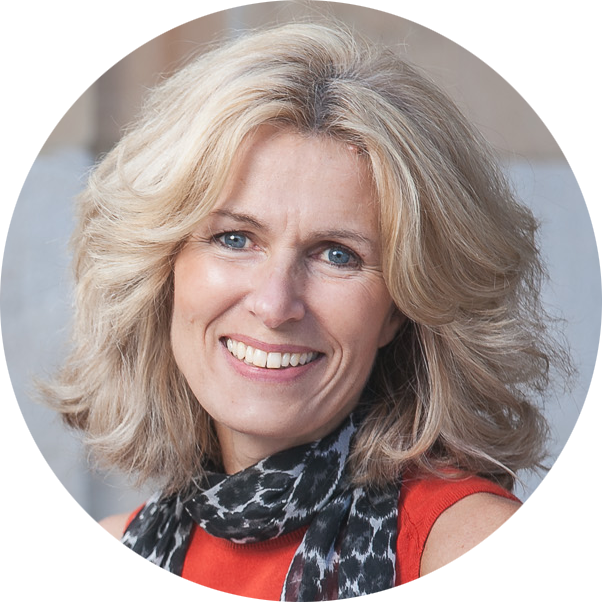
Liz was Formula Botanica’s Content Coordinator between August 2020-2024. Liz worked as a professional blogger, journalist and site developer for many years and was also part of the Formula Botanica student community. Read more about the Formula Botanica Team.

